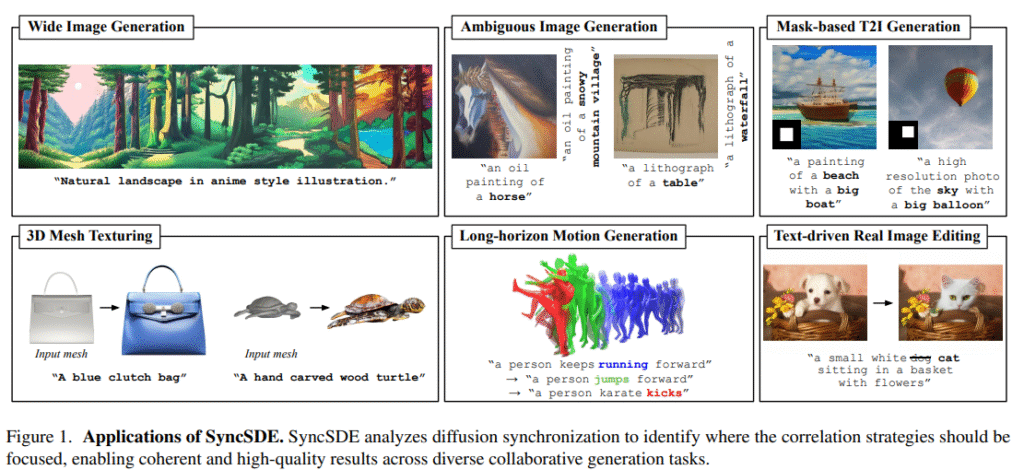Diffusion models have demonstrated significant success across various generative tasks, including image synthesis, 3D scene creation, video generation, and human motion modeling. However, their typical training on fixed-domain datasets limits their adaptability to varied formats and complex data structures. To overcome this, recent research has explored the collaborative use of multiple diffusion models by synchronizing their generation processes. These methods often rely on simple heuristics, such as averaging the predicted noise across trajectories, to align generations. While this approach can yield compelling results in tasks like panoramic image synthesis or optical illusions, it lacks task-specific customization and a theoretical explanation for why these strategies work. This leads to inconsistent performance and requires extensive trial-and-error for new tasks, limiting scalability and generalization.
Existing works like SyncTweedies and Visual Anagrams have shown the potential of such collaborative generation by synchronizing multiple diffusion paths. However, these rely on empirical testing of numerous heuristics—such as the 60 strategies explored in SyncTweedies—without offering insights into their effectiveness or generalizability. Despite successful applications across diverse domains, including UV texture mapping and compositional text-to-image generation, the absence of a theoretical foundation for synchronization hampers reliable adoption. While many methods leverage pretrained models to avoid extra training, relying on heuristic-based synchronization without understanding the underlying dynamics leaves room for error and inefficiency. The current study introduces a probabilistic framework to explicitly model the correlation between diffusion trajectories, offering the first formal basis for understanding and improving diffusion synchronization.
Researchers from Seoul National University and the Republic of Korea Air Force propose a probabilistic framework, called SyncSDE, to explain and optimize diffusion synchronization. Unlike prior methods that rely on fixed heuristics, their approach models the correlation between diffusion trajectories and adapts strategies to each task. By formulating synchronization as optimizing two distinct terms, they identify where and how heuristics should be applied for optimal results. This reduces trial-and-error and improves performance across tasks. Their method outperforms existing baselines, offering a theoretical foundation and practical scalability for various collaborative diffusion applications.
The SyncSDE framework enhances diffusion models by synchronizing image patches, where each patch is conditioned on previously generated ones. It modifies the standard diffusion process by incorporating a conditional score for the prior and the inter-patch dependencies. This allows for consistent and coherent outputs across various tasks, including mask-based text-to-image generation, real image editing, wide image completion, ambiguous image creation, and 3D mesh texturing. By leveraging spatial or semantic masks and overlapping patch conditioning, SyncSDE enables more controllable and structured image synthesis, ensuring smooth transitions and contextual consistency across complex visual scenes.
The study evaluates SyncSDE qualitatively and quantitatively across multiple collaborative generation tasks, comparing it with SyncTweedies and task-specific methods. SyncSDE consistently outperforms alternatives on metrics like KID, FID, and CLIP-S in functions such as mask-based and wide image generation, ambiguous image synthesis, text-driven real image editing, 3D mesh texturing, and long-horizon motion generation. It produces clearer, more coherent images without additional modules, unlike MultiDiffusion or Visual Anagrams. SyncSDE’s advantage stems from synchronizing multiple diffusion trajectories, with the hyperparameter λ controlling the collaboration strength. Overall, SyncSDE demonstrates superior generalization and versatility across diverse generative tasks.
In conclusion, the study introduces a probabilistic framework for diffusion synchronization, offering theoretical insights into its effectiveness. The method enables synchronized generation across tasks by modeling conditional probabilities between diffusion trajectories. Unlike prior approaches that rely on generic heuristics like score averaging, this work identifies specific probability terms to model, improving efficiency and task adaptability. Experimental results across multiple collaborative generation tasks show consistent outperformance over baselines. The framework clarifies why synchronization works and highlights the importance of task-specific correlation modeling. This principled approach provides a foundation for future research into more robust, adaptive models for multi-trajectory diffusion synchronization.
Here is the Paper. Also, don’t forget to follow us on Twitter and join our Telegram Channel and LinkedIn Group. Don’t Forget to join our 90k+ ML SubReddit.
The post SyncSDE: A Probabilistic Framework for Task-Adaptive Diffusion Synchronization in Collaborative Generation appeared first on MarkTechPost.
Source: Read MoreÂ



 [Register Now] miniCON Virtual Conference on AGENTIC AI: FREE REGISTRATION + Certificate of Attendance + 4 Hour Short Event (May 21, 9 am- 1 pm PST) + Hands on Workshop
[Register Now] miniCON Virtual Conference on AGENTIC AI: FREE REGISTRATION + Certificate of Attendance + 4 Hour Short Event (May 21, 9 am- 1 pm PST) + Hands on Workshop